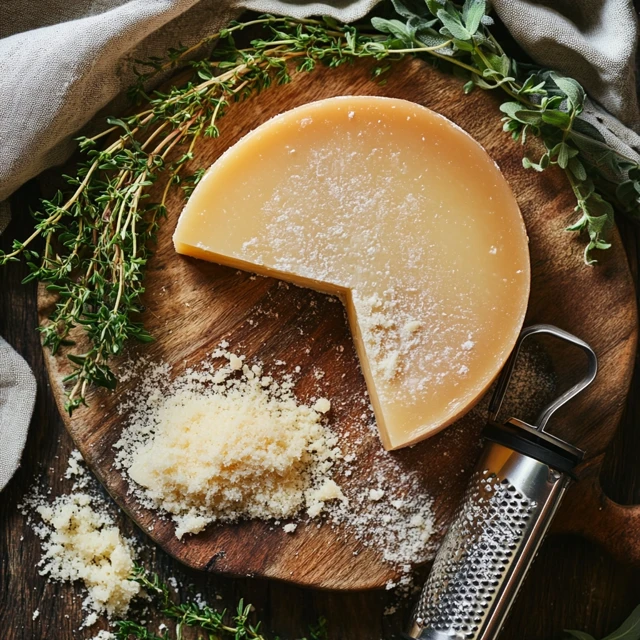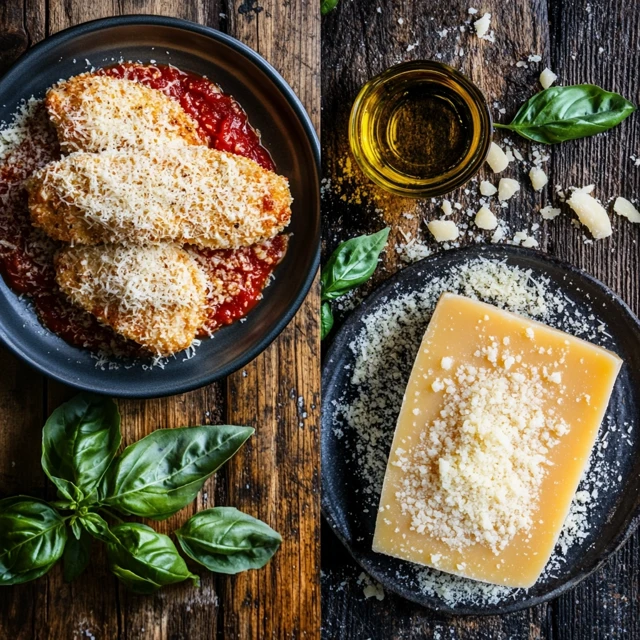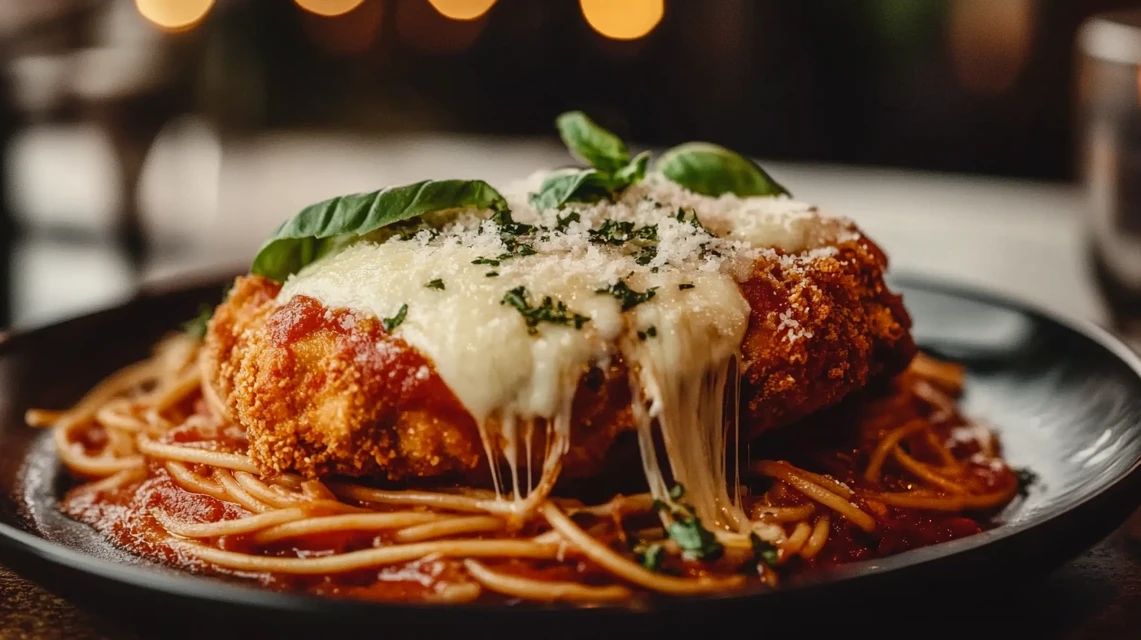Chicken Parmigiana and Parmesan cheese are staples in culinary traditions worldwide, often associated with rich, comforting flavors and Italian heritage. However, these two are fundamentally different. Chicken Parmigiana is a popular dish, while Parmesan is a versatile cheese. Understanding their origins and roles in cooking can help clarify the distinction between them.
Introduction to Chicken Parmigiana and Parmesan
Chicken Parmigiana and Parmesan cheese often go hand in hand in recipes, yet they serve entirely different purposes. Chicken Parmigiana is a complete dish featuring breaded chicken topped with marinara sauce and melted cheese. Parmesan, on the other hand, is a type of cheese used to enhance the flavor of numerous dishes, including Chicken Parmigiana.
Despite their differences, both share deep roots in Italian cuisine and have become integral to meals enjoyed around the globe. To truly appreciate these culinary icons, it’s helpful to explore their individual origins.
check out https://eassyrecipes.com/category/dinner/
The Origins of Chicken Parmigiana

Chicken Parmigiana, also known as Chicken Parmesan, is a dish with Italian-American roots that has become a beloved comfort food. Chefs layer breaded eggplant with tomato sauce and cheese, then bake it. This dish, called Melanzane alla Parmigiana (Eggplant Parmigiana), likely inspired today’s Chicken Parmesan.
How It Evolved:
- Immigration Influence: Italian immigrants to America in the early 20th century adapted traditional recipes using ingredients that were more readily available in the United States, such as chicken.
- Popularity in Restaurants: Chicken Parmigiana gained widespread appeal in Italian-American restaurants, where it became a hearty main course often served with pasta.
- Global Reach: The dish has since been embraced worldwide, with regional variations adding unique twists, such as including ham or prosciutto in Australian versions.
Key Characteristics:
- Main Components: Breaded chicken breast, marinara or tomato sauce, and melted mozzarella and Parmesan cheese.
- Cooking Method: Typically fried until golden brown, then baked to meld the flavors and melt the cheese.
- Flavor Profile: A combination of savory, tangy, and cheesy flavors with a crispy texture.
Chicken Parmigiana represents a fusion of Italian traditions and American innovation, making it a symbol of cultural exchange through food.
check out https://eassyrecipes.com/category/dinner/
The Origins of Parmesan Cheese
First of all, Parmesan cheese, officially known as Parmigiano-Reggiano, stands as one of Italy’s most iconic exports. Moreover, this hard, aged cheese has enriched Italian cuisine for centuries. As a result, people worldwide now revere it for its rich, nutty flavor and granular texture.
How It Originated:
- Early Production: Parmesan cheese originated in the Emilia-Romagna region of Italy, with historical records dating back to the 12th century.
- Protected Status: Italian law and EU rules now protect Parmesan cheese. Only specific regions can make and label cheese as Parmigiano-Reggiano, and they must follow traditional methods.
- Global Popularity: Thanks to its unique flavor and versatility, Parmesan is now a staple in kitchens worldwide, used for grating, shaving, or melting.
Key Characteristics:
- Production Process: Farmers make Parmesan from cow’s milk and age it for at least 12 months to create its complex flavor and crumbly texture.
- Flavor Profile: Nutty, salty, and umami-rich, Parmesan enhances a variety of dishes, from pasta to soups.
- Versatility: Used as a topping, ingredient, or seasoning, Parmesan adds depth to recipes without overpowering other flavors.
Parmesan cheese represents centuries of Italian craftsmanship and remains a cornerstone of traditional and modern cooking.
check out https://eassyrecipes.com/category/dinner/
Key Connection Between the Two
Chicken Parmigiana and Parmesan cheese share a connection through Italian culinary traditions, but they differ in their roles. While Chicken Parmigiana is a complete dish, Parmesan cheese is an ingredient that enhances the flavor of the dish. Understanding these origins helps highlight the distinct identities of these culinary staples.
Key Differences Between Chicken Parmigiana and Parmesan
Though they share Italian origins, Chicken Parmigiana and Parmesan cheese differ significantly in their purpose, flavor, and cultural significance. Let’s explore these key distinctions.
Dish vs. Ingredient
The primary difference lies in their nature: Chicken Parmigiana is a complete dish, while Parmesan is an ingredient.
- Chicken Parmigiana:
- A full entrée that combines breaded and fried chicken with marinara sauce and melted cheese.
- It is a standalone main course, often paired with side dishes like pasta, salad, or bread.
- The dish incorporates multiple components, including Parmesan cheese, but it is the preparation and assembly that define it.
- Parmesan Cheese:
- A single ingredient with a rich, nutty flavor that enhances a variety of dishes.
- It is typically grated, shaved, or melted into recipes to add depth and complexity.
- Parmesan can stand alone as a garnish or be integrated into recipes like sauces, soups, and salads.
This distinction highlights how Chicken Parmigiana is a meal, whereas Parmesan is a seasoning or flavor enhancer.
Flavor Profiles and Uses
The flavor profiles of Chicken Parmigiana and Parmesan differ greatly due to their components and preparation methods.
- Chicken Parmigiana:
- Flavor Profile: A blend of crispy, savory, and cheesy flavors with a tangy kick from the marinara sauce.
- Texture: Crispy breaded chicken contrasts with the gooey melted cheese and rich sauce, creating a multi-layered eating experience.
- Use: Served as a main dish, it satisfies as a hearty, flavorful meal.
- Parmesan Cheese:
- Flavor Profile: Nutty, salty, and umami-rich, with a crumbly texture that intensifies as it ages.
- Texture: Granular and firm, ideal for grating or shaving.
- Use: Enhances the taste of a variety of dishes, from pasta to risotto, and is also a key ingredient in recipes like Alfredo sauce or Caesar dressing.
While Chicken Parmigiana is about the interplay of ingredients, Parmesan cheese focuses on delivering bold, concentrated flavor in small amounts.
Cultural and Regional Significance
- Chicken Parmigiana:
- While inspired by Italian recipes, Chicken Parmigiana is primarily an Italian-American creation.
- It symbolizes the adaptation of traditional Italian flavors to the ingredients and tastes of American cuisine.
- In Australia, variations of Chicken Parmigiana are popular in pubs and are often served with chips or salad, showcasing its international reach.
- Parmesan Cheese:
- Parmigiano-Reggiano is a cornerstone of Italian culinary heritage.
- It is protected under Italian and European Union laws to preserve its traditional methods of production.
- The cheese represents the craftsmanship and history of Italy’s Emilia-Romagna region, making it a symbol of Italian identity.
Chicken Parmigiana reflects cultural adaptation and innovation, while Parmesan cheese embodies centuries-old tradition and artisanal excellence.
How Chicken Parmigiana and Parmesan Are Used in Cooking

Both Chicken Parmigiana and Parmesan cheese have specific roles in the culinary world, contributing distinct elements to a variety of dishes.
Chicken Parmigiana as a Main Dish
Chicken Parmigiana is a hearty entrée that can be customized to suit different tastes and occasions. Here’s how it’s typically used:
- Traditional Presentation:
- Chefs cover chicken with marinara sauce and add Parmesan and mozzarella cheese, then bake it until the cheese bubbles.
- It is often served with spaghetti or other pasta as a complete meal.
- Variations:
- Australian Style: Often paired with chips or salad and can include ham or prosciutto layered with the chicken.
- Lighter Options: Baked instead of fried for a healthier take on the dish.
- Vegetarian Version: Eggplant Parmigiana substitutes breaded eggplant for chicken, offering a plant-based alternative.
- Occasions:
- Chicken Parmigiana is perfect for family dinners, casual gatherings, or even special occasions when comfort food is desired.
Parmesan Cheese as a Versatile Ingredient
Parmesan is one of the most versatile ingredients in cooking, enhancing dishes with its bold flavor and rich texture.
- As a Garnish:
- Sprinkled over pasta, risotto, or soups for a finishing touch that adds depth and complexity.
- Shaved onto salads, such as Caesar salad, to enhance flavor and presentation.
- In Sauces:
- Parmesan is a key ingredient in creamy sauces like Alfredo and Carbonara, where its melting properties create a velvety texture.
- Adds richness to tomato-based sauces, complementing their acidity.
- Baking and Cooking:
- Incorporated into breading mixtures for dishes like Chicken Parmigiana or veal Milanese.
- Baked into savory pastries, breadsticks, or cheese crisps for added flavor.
- Aged Parmesan:
- Aged Parmesan can be grated into fine powder and used sparingly to pack a punch in recipes.
- The rind of Parmesan is often simmered in soups or stews to infuse them with umami.
Frequently Asked Questions
What is the difference between Chicken Parmesan and Chicken Parmigiana?
Chicken Parmesan and Chicken Parmigiana are essentially the same dish, with the names used interchangeably depending on the region. The difference lies mainly in terminology:
- Chicken Parmigiana:
- This is the traditional Italian name, reflecting its roots in Italian-American cuisine. It’s derived from Parmigiana di Melanzane (Eggplant Parmigiana), an Italian dish that uses breaded eggplant instead of chicken.
- The term “Parmigiana” references the addition of Parmesan cheese in the recipe or its inspiration from the Italian city of Parma.
- Chicken Parmesan:
- This is the anglicized version of the name, commonly used in the United States, Canada, and Australia.
- It is a simplified way of describing the dish for English-speaking audiences.
While the names differ, the ingredients and preparation remain consistent. Both refer to breaded chicken topped with marinara sauce, melted mozzarella, and Parmesan cheese.
Are Parmesan and Parmigiana the same?
While closely related, Parmesan and Parmigiana are not the same:
- Parmesan:
- Refers specifically to the cheese Parmigiano-Reggiano, a hard, aged cheese produced in the Emilia-Romagna region of Italy.
- Parmesan is often used as a garnish, seasoning, or an integral ingredient in recipes like Chicken Parmigiana, pasta dishes, and soups.
- Parmigiana:
- Refers to a style of cooking where ingredients (like eggplant, chicken, or veal) are breaded, fried, and topped with marinara sauce and cheese before being baked.
- The term “Parmigiana” is tied to the dish itself, rather than the specific cheese.
In short, Parmesan is an ingredient, while Parmigiana describes a preparation method that may include Parmesan cheese.
Why is it called Chicken Parm if it’s made with mozzarella?
Parmesan cheese gives Chicken Parm its name, and cooks include it in the breadcrumbs or sprinkle it on top, even though mozzarella stands out more in the final dish.
- Parmesan in the Breading:
- Cooks mix grated Parmesan cheese into the breadcrumbs to add a nutty, savory flavor to the breaded chicken.
- Mozzarella’s Role:
- Mozzarella is used because of its melting qualities, creating a gooey, cheesy layer that pairs perfectly with marinara sauce.
- Historical Context:
- The name likely stuck because Parmesan cheese was an iconic ingredient in Italian cooking, making it a shorthand for dishes with Italian-American roots.
Despite mozzarella being the star of the cheesy topping, Parmesan remains an essential element in the dish’s identity.
How do Italians say Chicken Parmesan?
In Italy, the dish is referred to as Pollo alla Parmigiana. Here’s the breakdown of the name:
- Pollo: Italian for “chicken.”
- Alla: Translates to “in the style of” or “prepared as.”
- Parmigiana: Refers to the preparation style, which includes breading, frying, and topping with marinara sauce and cheese.
However, it’s important to note that Chicken Parmigiana is not a traditional Italian dish. Instead, it’s an Italian-American creation inspired by Melanzane alla Parmigiana (Eggplant Parmigiana). In Italy, the focus would typically be on eggplant or veal Parmigiana rather than chicken.
Conclusion: Understanding the Difference
Chicken Parmigiana and Parmesan cheese are staples of Italian-inspired cuisine, but they serve distinct roles. Chicken Parmigiana is a complete dish, combining breaded chicken with marinara sauce, melted mozzarella, and Parmesan cheese. Parmesan, on the other hand, is an ingredient that adds depth and richness to a variety of recipes.
Key takeaways to understand the difference:
- Chicken Parmigiana: A hearty, Italian-American main dish with global popularity.
- Parmesan Cheese: A hard, nutty cheese that enhances the flavor of dishes as a garnish, seasoning, or primary ingredient.
- Cultural Context: Chicken Parmigiana represents the adaptation of Italian flavors in American cuisine, while Parmesan cheese reflects traditional Italian craftsmanship.
Whether you’re enjoying Chicken Parmigiana or sprinkling Parmesan on pasta, both represent the delicious versatility of Italian cuisine. Together, they create a perfect harmony of flavors that continues to delight food lovers worldwide.

